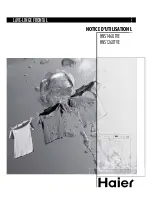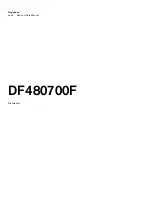
1-9
Basic Information
Dispenser Flow Pattern
Automatic Dispenser Operation
The automatic dispenser for the detergent, liquid bleach
and fabric softener system is made up of the dispenser
cavity, and a removable drawer with four cavities: one
for pre-wash, one for detergent, one for bleach and one
for fabric softener. A plastic conveyer is snapped to the
bottom of the drawer to direct the outputs from the bleach
and softener chambers to the dispenser housing outlet
channel. This prevents the mixtures from coming out the
front of the drawer.
The 3 outlets of the water inlet valve assembly are
inserted into the rear of the automatic dispenser. During
the fi ll cycles, water is directed into the top of the cavity
through 3 inlets. The inlet on the right, as viewed from
the front of the washer, is connected to the combination
output of the hot water solenoid and the center cold water
solenoid.
The left and middle inlet, as viewed from the front of the
washer, are connected to the cold water solenoid.
In the fi ll cycle, water enters into the top of cavity and is
directed across the top of the cavity by 5 channels: the
dispenser advanced rinsing technology channel, the
pre-wash channel (cold water only), the detergent
channel, bleach channel and the fabric softener channel.
The channel that receives the water is determined by
which inlet supplies the water or if both inlets supply the
water.
The dispenser advanced rinsing technology channel
receives water whenever the inlet on the right, as viewed
from the front of the washer, is activated. This path
allows the water to bypass the dispenser drawer and
enter the tub by the advanced rinsing technology hose
connected between the cavity and the bellows.
The pre-wash dispenser channel receives water from the
left-hand input, as viewed from the front of the washer.
The pre-wash channel forms a loop that allows the
water to pass over the pre-wash detergent section of the
drawer.
As the water passes over the pre-wash detergent section,
holes in the cavity allows some of the water to enter and
fl ush the pre-wash detergent cavity. Since the fl ow of the
incoming water is more than the holes can dispense, the
excess water backs up into a channel across the rear
of the dispenser. Water in this channel and the mixture
from the detergent drawer fl ow into the tub through the
large hose at the rear of the dispenser.
The detergent dispenser channel receives water from the
right-hand input, as viewed from the front of the washer.
The detergent channel forms a loop that allows the water
to pass over the detergent section of the drawer. As the
water passes over the detergent section, holes in the
cavity allow some of the water to enter and fl ush the
detergent cavity. Since the fl ow of incoming water is
more than the holes can dispense, the excess water
backs up into a channel across the rear of the dispenser.
Water in this channel and the mixture from the detergent
drawer fl ow into the tub through the large hose at the rear
of the dispenser.
Detergent is dispensed at the start of the cycle, but
bleach and fabric softener are not dispensed until later in
the cycle. The bleach and softener cavities in the drawer
have tubes molded into the bottom of them.
These tubes allow bleach or fabric softener to be added
to their cavity without being dispensed as long as the
liquid is below the top of the tubes. At the proper time
in the cycle when bleach or fabric softener is to be
dispensed, water is added to the cavity. This raises the
mixture above the top of the tube and the bleach or fabric
softener starts fl owing into the tub.
Main Wash
Detergent
Channel
Pre-Wash
Detergent
Channel
To ART
Hose
Bleach
Channel
Fabric
Softener
Channel
Summary of Contents for EIFLW55H MB
Page 2: ......
Page 14: ...1 12 Basic Information Notes ...
Page 20: ...Installation Information 2 6 Installed Washer Dimensions ...
Page 36: ...Installation Information 2 22 Notes ...
Page 38: ...Electronic Control 3 2 Wave Touch Washer Cycle Chart ...
Page 40: ...Electronic Control 3 4 IQ Touch Washer Cycle Chart ...
Page 57: ...Electronic Control 3 21 Error Code Chart ...
Page 58: ...Electronic Control 3 22 Error Code Test Chart ...
Page 59: ...Electronic Control 3 23 Error Code Test Chart ...
Page 60: ...Electronic Control 3 24 Notes ...
Page 82: ...Component Teardown 4 22 Notes ...
Page 88: ...Troubleshooting 5 6 Notes ...
Page 89: ...Wiring Schematics 6 1 Model EWFLW65H EIFLW55H ...
Page 90: ...Wiring Schematics 6 2 Notes ...












































